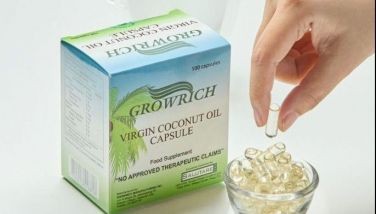Good carbs with fiber are in for 2005

July 17, 2005 | 12:00am
Buck up buckwheat. Way to go pinto. For whole grain, beans, fruits and vegetables it’s time to shine for carbohydrates that are high in fiber. Good carbs are replacing low carbs in shopping carts as America works toward weight loss and better health. Simple and complex carbohydrates that are high in fiber are now topping the charts, while processed and refined sugars remain out for 2005. "ProductScan Online reported in September that the percentage of new food products making a high fiber claim has nearly doubled in 2004, from 2.5 percent to 4.2 percent, according to the Natural Food Merchandiser explaining that savvy shoppers are gravitating toward fiber rich carbohydrates rather than avoiding carbs altogether. Although it may be premature to declare the death of low carb foods, many food industry analysts say that the movement is at least deeply wounded the New York Times reported December 5, 2004. This turn of events is very positive say dietitians and nutritionists who recognize that fiber rich whole plant foods are essential to losing weight and keeping it off, while helping to prevent cancer and heart disease.
Fiber is much more than a trend. Eating plenty of whole grain, beans, fruit and vegetables is a lifelong necessity. In addition to fiber, vitamins, and minerals, whole plant foods contain a wealth of antioxidant phytonutrients; natural nutraceuticals that help prevent disease. Compounds like lycopene in cruciferous vegetables, chlorophyll and bioflavonoids that make up the colors of fruit, vegetables, and beans . . . all of these help the body to fight oxidation and carcinogens. There are two kinds of fiber: soluble fiber that dissolves in water, and insoluble fiber that does not. Insoluble fiber or roughage helps to create solid, healthy bowel movements. Soluble fiber helps to lower blood cholesterol and glucose levels. Think of soluble fiber as a ‘cholesterol sponge’, sopping up the bad LDL cholesterol and removing it before it can cause arterial plaque and heart disease, and think of insoluble fiber as a scrubber, keeping your entire digestive tract in good working order. In addition to helping prevent heart disease, a high fiber diet may lower your risk of type-2 diabetes, colon cancer, hemorrhoids, irritable bowel syndrome, and diverticular disease.
Fiber can help with weight control. In the April 1997 issue of Journal of Nutrition researchers found that the more fiber people ate, the more fat ended up in their stool. Not only does fiber prevent absorption of fat, but it also helps you to feel satiate faster. As you fill up on high fiber foods like grains, fruit, and vegetables, you’ll have less desire for high fat and highly calorie low fiber foods. The new USDA dietary recommendations expected for release early 2005 will emphasize a high fiber diet. Currently Americans get an average of 12 grams of fiber per day and according to the National Academy of Sciences we need two to three times more than that. So how do we take in the additional fiber we so desperately need? Whole plant foods are almost always good source of both insoluble and soluble fiber. For packaged food, always read the label. A ‘good source’ provides 10 to 19 percent daily value (DV) of fiber per serving, nd an ‘excellent source’ provides 20 percent or more DV. Beyond fiber conent be sure to choose whole natural food rather than food that has been processed and refined.
Regrettably, most processors strip food of natural fiber and valuable phytonutrients and then add cheap laboratory made fiber powders to meet a label requirement. Choose a brand you trust, favor organic when possible, and when in doubt ask the manufacturer specifically where their fiber is coming from.
Fiber is much more than a trend. Eating plenty of whole grain, beans, fruit and vegetables is a lifelong necessity. In addition to fiber, vitamins, and minerals, whole plant foods contain a wealth of antioxidant phytonutrients; natural nutraceuticals that help prevent disease. Compounds like lycopene in cruciferous vegetables, chlorophyll and bioflavonoids that make up the colors of fruit, vegetables, and beans . . . all of these help the body to fight oxidation and carcinogens. There are two kinds of fiber: soluble fiber that dissolves in water, and insoluble fiber that does not. Insoluble fiber or roughage helps to create solid, healthy bowel movements. Soluble fiber helps to lower blood cholesterol and glucose levels. Think of soluble fiber as a ‘cholesterol sponge’, sopping up the bad LDL cholesterol and removing it before it can cause arterial plaque and heart disease, and think of insoluble fiber as a scrubber, keeping your entire digestive tract in good working order. In addition to helping prevent heart disease, a high fiber diet may lower your risk of type-2 diabetes, colon cancer, hemorrhoids, irritable bowel syndrome, and diverticular disease.
Fiber can help with weight control. In the April 1997 issue of Journal of Nutrition researchers found that the more fiber people ate, the more fat ended up in their stool. Not only does fiber prevent absorption of fat, but it also helps you to feel satiate faster. As you fill up on high fiber foods like grains, fruit, and vegetables, you’ll have less desire for high fat and highly calorie low fiber foods. The new USDA dietary recommendations expected for release early 2005 will emphasize a high fiber diet. Currently Americans get an average of 12 grams of fiber per day and according to the National Academy of Sciences we need two to three times more than that. So how do we take in the additional fiber we so desperately need? Whole plant foods are almost always good source of both insoluble and soluble fiber. For packaged food, always read the label. A ‘good source’ provides 10 to 19 percent daily value (DV) of fiber per serving, nd an ‘excellent source’ provides 20 percent or more DV. Beyond fiber conent be sure to choose whole natural food rather than food that has been processed and refined.
Regrettably, most processors strip food of natural fiber and valuable phytonutrients and then add cheap laboratory made fiber powders to meet a label requirement. Choose a brand you trust, favor organic when possible, and when in doubt ask the manufacturer specifically where their fiber is coming from.
BrandSpace Articles
<
>
- Latest
- Trending
Trending
Latest
Latest
Recommended

June 22, 2025 - 12:00am






























